An Analysis of Eco-Technology Allowing Water and Energy Saving in an Environmentally Friendly House—A Case Study from Poland
Abstract
1. Introduction
2. Materials and Methods
2.1. Case Study
- Graywater Recycling System (GWRS),
- Rainwater Harvesting System (RWHS),
- Solar Collectors (SC),
- Photovoltaic Panels (PP),
- Air Heat Pump (AHP),
- Ground Heat Pump (GHP),
- Wind Turbine (WT),
- Drain Water Heat Recovery (DWHR),
- Biomass Boiler (BB).
2.2. GWRS Description
2.3. RWHS Description
2.4. SC Description
2.5. PP Description
2.6. AHP and GHP Description
2.7. Wind Turbine
2.8. DWHR Description
2.9. BB Description
2.10. Financial and Environmental Analysis
2.11. Sensitivity Analysis
- Scenario A—a change in the initial value of investments.
- Scenario B—a change in the value of operating costs resulting from the amount of consumed electricity.
- Scenario C—a change in the value of operating costs resulting from the amount of used tap water and the amount of sanitary sewage discharged from the building to the sewage system.
- Scenario D—a change in the value of operating costs resulting from the amount of used electricity and tap water, and the amount of sanitary sewage discharged from the building to the sewage system.
3. Results and Discussion
3.1. The Results of the LCC Analysis
3.2. The Results of Sensitivity Analysis
- the number of occupants: Oc = 4 persons,
- shower length: lsh = 8 min/person/day.
3.3. The Results of the Environmental Analysis
4. Conclusions
Author Contributions
Funding
Conflicts of Interest
References
- Urbaniec, K.; Mikulčić, H.; Rosen, M.A.; Duić, N. A holistic approach to sustainable development of energy, water and environment system. J. Clean. Prod. 2017, 155, 1–11. [Google Scholar] [CrossRef]
- Balibar, S. Energy transitions after COP21 and 22. Comptes Rendus Physique 2017, 18, 479–487. [Google Scholar] [CrossRef]
- US EPA. Inventory of U.S. Greenhouse Gas Emissions and Sinks:1990–2014. EPA 430-R-16-002; U.S. Environmental Protection Agency: Washington, DC, USA, 2016.
- Cao, Y.; Pawłowski, A. Biomass as an answer to sustainable energy. Opportunity versus challenge. Environ. Prot. Eng. 2013, 1, 153–161. [Google Scholar] [CrossRef]
- Huisingh, D.; Zhang, Z.; Moore, J.C.; Qiao, Q.; Li, Q. Recent advances in carbon emissions reduction: Policies, technologies, monitoring, assessment and modeling. J. Clean. Prod. 2015, 103, 1–12. [Google Scholar] [CrossRef]
- Mohammadi, M.; Ghasempour, R.; Astaraei, F.; Ahmadi, E.; Aligholian, A.; Toopshekan, A. Optimal planning of renewable energy resource for a residential house considering economic and reliability criteria. Int. J. Electr. Power 2018, 96, 261–273. [Google Scholar] [CrossRef]
- Wan Alwi, S.R.; Klemeš, J.J.; Varbanov, P.S. Cleaner energy planning, management and technologies: Perspectives of supply-demand side and end-of-pipe management. J. Clean. Prod. 2016, 136, 1–13. [Google Scholar] [CrossRef]
- Couto, E.; Calijuri, M.L.; Assemany, P.; Fonseca Santiago, A.; Lopes, L. Greywater treatment in airports using anaerobic filter followed by UV disinfection: An efficient and low cost alternative. J. Clean. Prod. 2015, 106, 372–379. [Google Scholar] [CrossRef]
- UN. World Population Prospects: The 2017 Revision. Population Division. ESA/P/WP/248; United Nations, Department of Economic and Social Affairs: New York, NY, USA, 2017. [Google Scholar]
- WWAP (United Nations World Water Assessment Programme). The United Nations World Water Development Report 2015: Water for a Sustainable World; UNESCO: Paris, France, 2015. [Google Scholar]
- Salvadore, E.; Bronders, J.; Batelaan, O. Hydrological modelling of urbanized catchments: A review and future directions. J. Hydrol. 2015, 529, 62–81. [Google Scholar] [CrossRef]
- United Nations, Department of Economic and Social Affairs, Population Division. World Urbanization Prospects: The 2014 Revision, Highlights; United Nation: New York, NY, USA, 2015. [Google Scholar]
- Oudin, L.; Salavati, B.; Furusho-Percot, C.; Ribstein, P.; Saadi, M. Hydrological impacts of urbanization at the catchment scale. J. Hydrol. 2018, 559, 774–786. [Google Scholar] [CrossRef]
- Chang, N.; Lu, J.; Chui, T.; Hartshorn, N. Global policy analysis of low impact development for stormwater management in urban regions. Land Use Policy 2018, 70, 368–383. [Google Scholar] [CrossRef]
- Eckart, K.; McPhee, Z.; Bolisetti, T. Performance and implementation of low impact development—A review. Sci. Tot. Environ. 2017, 607–608, 413–432. [Google Scholar] [CrossRef] [PubMed]
- Liu, Y.; Ahiablame, L.M.; Bralts, V.F.; Engel, B.A. Enhancing a rainfall-runoff model to assess the impacts of BMPs and LID practices on storm runoff. J. Environ. Manag. 2015, 147, 12–23. [Google Scholar] [CrossRef] [PubMed]
- Rose, S.; Peters, N.E. Effects of urbanization on streamflow in the Atlanta area (Georgia, USA): A comparative hydrological approach. Hydrol. Process. 2001, 15, 1441–1457. [Google Scholar] [CrossRef]
- Fletcher, T.D.; Andrieu, H.; Hamel, P. Understanding, management and modelling of urban hydrology and its consequences for receiving waters: A state of the art. Adv. Water Resour. 2013, 51, 261–279. [Google Scholar] [CrossRef]
- Słyś, D.; Stec, A. Effect of development of the town of Przemysl on operation of its sewerage system. Ecol. Chem. Eng. S 2013, 20, 381–396. [Google Scholar] [CrossRef]
- Stovin, V.R.; Moore, S.L.; Wall, M.; Ashley, R.M. The potential to retrofit sustainable drainage systems to address combined sewer overflow discharges in the Thames Tideway catchment. Water Environ. J. 2013, 27, 216–228. [Google Scholar] [CrossRef]
- Deng, X.; Zhao, C.; Yan, H. Systematic modeling of impacts of land use and land cover changes on regional climate: A review. Adv. Meteorol. 2013, 2013. [Google Scholar] [CrossRef]
- Al-Kodmany, K. Sustainability and the 21st Century Vertical City: A Review of Design Approaches of Tall Buildings. Buildings 2018, 8, 102. [Google Scholar] [CrossRef]
- Zhang, X.; Bayulken, B.; Skitmore, M.; Lu, W.; Huisingh, D. Sustainable urban transformations towards smarter, healthier cities: Theories, agendas and pathways. J. Clean. Prod. 2018, 173, 1–10. [Google Scholar] [CrossRef]
- Childers, D.L.; Cadenasso, M.L.; Grove, J.; Marshall, V.; McGrath, B.; Pickett, S. An Ecology for Cities: A Transformational Nexus of Design and Ecology to Advance Climate Change Resilience and Urban Sustainability. Sustainability 2015, 7, 3774–3791. [Google Scholar] [CrossRef]
- Pedersen Zari, M. Biomimetic Urban Design: Ecosystem Service Provision of Water and Energy. Buildings 2017, 7, 21. [Google Scholar] [CrossRef]
- Gurgun, A.P.; Arditi, D. Assessment of Energy Credits in LEED-Certified Buildings Based on Certification Levels and Project Ownership. Buildings 2018, 8, 29. [Google Scholar] [CrossRef]
- Lü, X.; Lu, T.; Kibert, C.J.; Viljanen, M. Modeling and forecasting energy consumption for heterogeneous buildings using a physical-statistical approach. Appl. Energy 2015, 144, 261–275. [Google Scholar] [CrossRef]
- EU. EU Energy in Figures. Statistical Pocketbook; European Commission: Brussels, Belgium, 2016. [Google Scholar]
- Gou, Z.; Prasad, D.; Siu-Yu Lau, S. Are green buildings more satisfactory and comfortable? Habitat Int. 2013, 39, 156–161. [Google Scholar] [CrossRef]
- US EPA. Definition of Green Building US; Environmental Protection Agency: Washington, DC, USA, 2009.
- Diamond, R.C.; Ye, Q.; Feng, W.; Yan, T.; Mao, H.; Li, Y.; Guo, Y.; Wang, J. Sustainable Building in China—A Green Leap Forward? Buildings 2013, 3, 639–658. [Google Scholar] [CrossRef]
- Hwang, B.G.; Tan, J.S. Green building project management: Obstacles and solutions for sustainable development. Sustain. Dev. 2012, 20, 335–349. [Google Scholar] [CrossRef]
- Shealy, T. Do sustainable buildings inspire more sustainable buildings? Procedia Eng. 2016, 145, 412–419. [Google Scholar] [CrossRef]
- Maruejols, L.; Ryan, D.L.; Young, D. Eco-houses and the environment: A case study of occupant experiences in a cold climate. Energy Build. 2013, 62, 368–380. [Google Scholar] [CrossRef]
- Volf, M.; Lupíšek, A.; Bureš, M.; Nováček, J.; Hejtmánek, P.; Tywoniak, J. Application of building design strategies to create an environmentally friendly building envelope for nearly zero-energy buildings in the central European climate. Energy Build. 2018, 165, 35–46. [Google Scholar] [CrossRef]
- Gou, Z. Human Factors in Green Building: Building Types and Users’ Needs. Buildings 2019, 9, 17. [Google Scholar] [CrossRef]
- Dahy, H. Materials as a Design Tool’ Design Philosophy Applied in Three Innovative Research Pavilions Out of Sustainable Building Materials with Controlled End-Of-Life Scenarios. Buildings 2019, 9, 64. [Google Scholar] [CrossRef]
- Matias, J.C.O.; Santos, R.; Abreu, A. A Decision Support Approach to Provide Sustainable Solutions to the Consumer, by Using Electrical Appliances. Sustainability 2019, 11, 1143. [Google Scholar] [CrossRef]
- Abd-ur-Rehman, H.M.; Al-Sulaiman, F.A.; Mehmood, A.; Shakir, S.; Umer, M. The potential of energy savings and the prospects of cleaner energy production by solar energy integration in the residential buildings of Saudi Arabia. J. Clean. Prod. 2018, 183, 1122–1130. [Google Scholar] [CrossRef]
- Vieira, A.S.; Stewart, R.A.; Beal, C.D. Air source heat pump water heaters in residential buildings in Australia: Identification of key performance parameters. Energy Build. 2015, 91, 148–162. [Google Scholar] [CrossRef]
- Rivoire, M.; Casasso, A.; Piga, B.; Sethi, R. Assessment of Energetic, Economic and Environmental Performance of Ground-Coupled Heat Pumps. Energies 2018, 11, 1941. [Google Scholar] [CrossRef]
- Xydis, G. Wind Energy Integration through District Heating. A Wind Resource Based Approach. Resources 2015, 4, 110–127. [Google Scholar] [CrossRef]
- Las-Heras-Casas, J.; López-Ochoa, L.M.; Paredes-Sánchez, J.P. Implementation of biomass boilers for heating and domestic hot water in multi-family buildings in Spain: Energy, environmental, and economic assessment. J. Clean. Prod. 2018, 176, 590–603. [Google Scholar] [CrossRef]
- Mazur, A. An assessment of the financial efficiency of a heat recovery system from graywater in a hotel. In Proceedings of the E3S Web of Conferences Volume 45—VI International Conference of Science and Technology INFRAEKO 2018 Modern Cities, Infrastructure and Environment, Krakow, Poland, 7–8 June 2018; p. 00051. [Google Scholar] [CrossRef]
- Mazur, A. The impact of using of a DWHR heat exchanger on operating costs for a heat water preparation system and the amount of carbon dioxide emissions entering the atmosphere. In Proceedings of the E3S Web of Conferences Volume 45—VI International Conference of Science and Technology INFRAEKO 2018 Modern Cities, Infrastructure and Environment, Krakow, Poland, 7–8 June 2018; p. 00052. [Google Scholar] [CrossRef]
- Kordana, S.; Pochwat, K.; Słyś, D.; Starzec, M. Opportunities and threats of implementing drain water heat recovery units in Poland. Resources 2019, 8, 88. [Google Scholar] [CrossRef]
- Kretschmer, F.; Neugebauer, G.; Stoeglehner, G.; Ertl, T. Participation as a Key Aspect for Establishing Wastewater as a Source of Renewable Energy. Energies 2018, 11, 3232. [Google Scholar] [CrossRef]
- Mazhar, A.R.; Liu, S.; Shukla, A. A Key Review of Non-Industrial Greywater Heat Harnessing. Energies 2018, 11, 386. [Google Scholar] [CrossRef]
- Willis, R.M.; Stewart, R.A.; Giurco, D.P.; Talebpour, M.R.; Mousavinejad, A. End use water consumption in households: Impact of socio-demographic factors and efficient devices. J. Clean. Prod. 2013, 60, 107–115. [Google Scholar] [CrossRef]
- Amos, C.C.; Rahman, A.; Mwangi Gathenya, J. Economic analysis and feasibility of rainwater harvesting systems in urban and peri-urban environments: A review of the global situation with a special focus on Australia and Kenya. Water 2016, 8, 149. [Google Scholar] [CrossRef]
- Bashar, M.; Karim, R.; Imteaz, M.A. Reliability and economic analysis of urban rainwater harvesting: A comparative study within six major cities of Bangladesh. Resour. Conserv. Recycl. 2018, 133, 146–154. [Google Scholar] [CrossRef]
- Vranayova, Z.; Kaposztasova, D.; Poorova, Z. Water management of “smart” buildings and cities. J. Civ. Eng. Environ. Arch. 2018, 65, 45–52. [Google Scholar] [CrossRef]
- Imteaz, M.A.; Matos, C.; Shanableh, A. Impacts of climatic variability on rainwater tank outcomes for an inland city, Canberra. Int. J. Hydrol. Sci. Technol. 2014, 4, 177–191. [Google Scholar] [CrossRef]
- Kaposztasova, D.; Vranayova, Z.; Markovic, G.; Purcz, P. Rainwater Harvesting, Risk Assessment and Utilization in Kosice-city, Slovakia. Procedia Eng. 2014, 89, 1500–1506. [Google Scholar] [CrossRef][Green Version]
- García-Montoya, M.; Sengupta, D.; Nápoles-Rivera, F.; Ponce-Ortega, J.M.; El-Halwagi, M.M. Environmental and economic analysis for the optimal reuse of water in a residential complex. J. Clean. Prod. 2016, 130, 82–91. [Google Scholar] [CrossRef]
- Słyś, D.; Stec, A. The analysis of variants of water supply systems in multi-family residential building. Ecol. Chem. Eng. S 2014, 21, 623–635. [Google Scholar] [CrossRef]
- Stec, A.; Zeleňáková, M. An Analysis of the Effectiveness of Two Rainwater Harvesting Systems Located in Central Eastern Europe. Water 2019, 11, 458. [Google Scholar] [CrossRef]
- Imteaz, M.A.; Ahsan, A.; Shanableh, A. Reliability analysis of rainwater tanks using daily water balance model: Variations within a large city. Resour. Conserv. Recycl. 2013, 77, 37–43. [Google Scholar] [CrossRef]
- Jeong, H.; Broesicke, O.A.; Drew, B.; Crittenden, J.C. Life cycle assessment of small-scale greywater reclamation systems combined with conventional centralized water systems for the City of Atlanta, Georgia. J. Clean. Prod. 2018, 174, 333–342. [Google Scholar] [CrossRef]
- Leong, J.Y.C.; Oh, K.S.; Poh, P.E.; Chong, M.N. Prospects of hybrid rainwater-greywater decentralised system for water recycling and reuse: A review. J. Clean. Prod. 2017, 142, 3014–3027. [Google Scholar] [CrossRef]
- Walczykiewicz, T. Scenarios of Water Resources Development in Poland up to 2030. Water Resour. 2014, 41, 763–773. [Google Scholar] [CrossRef]
- Morales-Pinzón, T.; Rieradevall, J.; Gasol, C.M.; Gabarrell, X. Modelling for economic cost and environmental analysis of rainwater harvesting systems. J. Clean. Prod. 2015, 87, 613–626. [Google Scholar] [CrossRef]
- Ramadan, M.; Lemenand, T.; Khaled, M. Recovering heat from hot drain water—Experimental evaluation, parametric analysis and new calculation procedure. Energy Build. 2016, 128, 575–582. [Google Scholar] [CrossRef]
- Słyś, D.; Kordana, S. Financial analysis of the implementation of a Drain Water Heat Recovery unit in residential housing. Energy Build. 2014, 71, 1–11. [Google Scholar] [CrossRef]
- Chudzicki, J.; Sosnowski, S. Instalacje Wodociągowe: Projektowanie, Wykonanie, Eksploatacja (Water Supply Systems: Design, Construction, Operation), 2nd ed.; Seidel-Przywecki Sp.: Warszawa, Poland, 2009. [Google Scholar]
- Słyś, D. Potential of rainwater utilization in residential housing in Poland. Water Environ. J. 2009, 23, 318–325. [Google Scholar] [CrossRef]
- Bayrak, F.; Ertürk, G.; Oztop, H.F. Effects of partial shading on energy and exergy efficiencies for photovoltaic panels. J. Clean. Prod. 2017, 164, 58–69. [Google Scholar] [CrossRef]
- Dávi, G.; Caamaño-Martín, E.; Rüther, R.; Solano, J. Energy performance evaluation of a net plus-energy residential building with grid-connected photovoltaic system in Brazil. Energy Buildings. 2016, 120, 19–29. [Google Scholar] [CrossRef]
- Pisarev, V. Alternatywne Źródła Energii—Instalacje z Pompami Ciepła (Alternative Energy Sources—Installations with Heat Pumps); Oficyna Wydawnicza Politechniki Rzeszowskiej: Rzeszów, Poland, 2012. [Google Scholar]
- Wiśniewski, W. Określenie Potencjału Energetycznego Regionów Polski w Zakresie Odnawialnych Źródeł Energii-Wnioski dla Regionalnych Programów Operacyjnych na Okres Programowania 2014–2020; Wydawnictwo Instytutu Energetyki Odnawialnej: Warszawa, Poland, 2011. [Google Scholar]
- Fidewicz, S. Wykorzystanie Ciepła Odpadowego Jako Działanie Proefektywnościowe w Dziedzinie Gospodarki Energetycznej (Exploitation of Waste Heat as Pro-Effectiveness Actions in the Field of Energy Management). Available online: http://ilabepro.polsl.pl/spep/raporty/energetyka-odpadowa/Fidewicz%20Sz.%20Ciep%C5%82o%20odpadowe%20w%20domu.pdf (accessed on 5 February 2019).
- Janowicz, L. Biomasa w Polsce. Energetyka I Ekologia 2006, 8, 601–604. [Google Scholar]
- Moschetii, R.; Brattebø, H. Combining Life Cycle Environmental and Economic Assessments in Building Energy Renovation Projects. Energies 2017, 10, 1851. [Google Scholar] [CrossRef]
- Fantozzi, F.; Gargari, C.; Rovai, M.; Salvadori, G. Energy Upgrading of Residential Building Stock: Use of Life Cycle Cost Analysis to Assess Interventions on Social Housing in Italy. Sustainability 2019, 11, 1452. [Google Scholar] [CrossRef]
- Fuller, S.; Petersen, S. Life Cycle Costing Manual for the Federal Energy Management Program/National Institute of Standards and Technology. NIST Handbook 135; U.S. Department of Energy: Washington, DC, USA, 1996. Available online: www.fire.nist.gov/bfrlpubs/build96/PDF/b96121.pdf.
- Spickova, M.; Myskova, R. Costs Efficiency Evaluation Using Life Cycle Costing as Strategic Method. Procedia Econ. Financ. 2015, 34, 337–343. [Google Scholar] [CrossRef]
- Bierer, A.; Götze, U.; Meynerts, L.; Sygulla, R. Integrating life cycle costing and life cycle assessment using extended material flow cost accounting. J. Clean. Prod. 2015, 108, 1289–1301. [Google Scholar] [CrossRef]
- DOE. Life Cycle Cost Handbook. Guidance for Life Cycle Cost Estimation and Analysis. Office of Acquisition and Project Management. U.S. Department of Energy: Washington, DC, USA, 2018. Available online: www.directives.doe.gov%2Fdirectives-documents%2F400-series%2F0413.3-EGuide-21A%2F%40%40images%2Ffile&usg=AOvVaw3IH9WzkaxdeQmJ8Edx59Qg (accessed on 21 June 2019).
- Rahman, A.; Keane, J.; Imteaz, A.M. Rainwater harvesting in Greater Sydney: Water savings, reliability and economic benefits. Resour. Conserv. Recycl. 2012, 61, 16–21. [Google Scholar] [CrossRef]
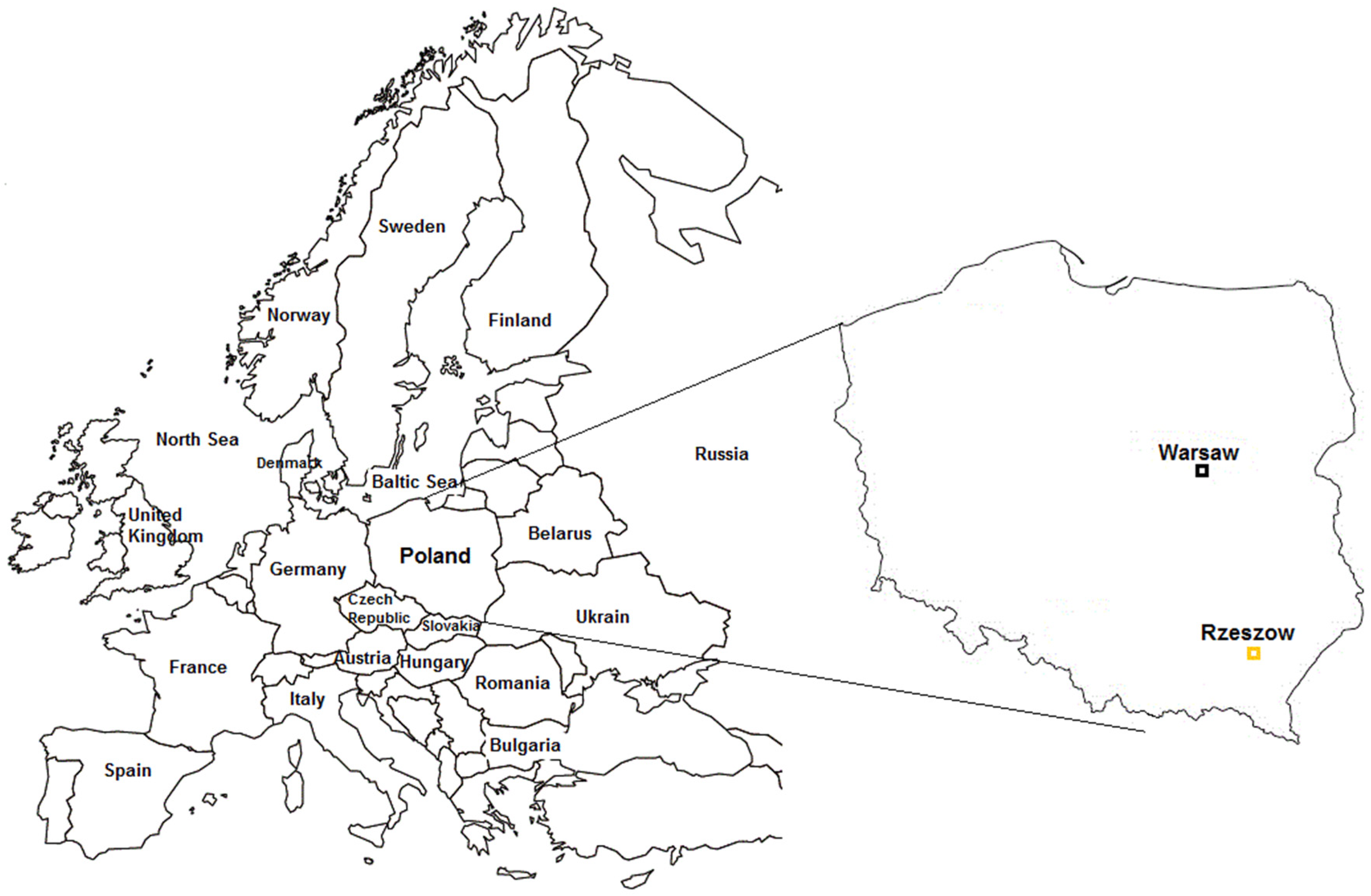
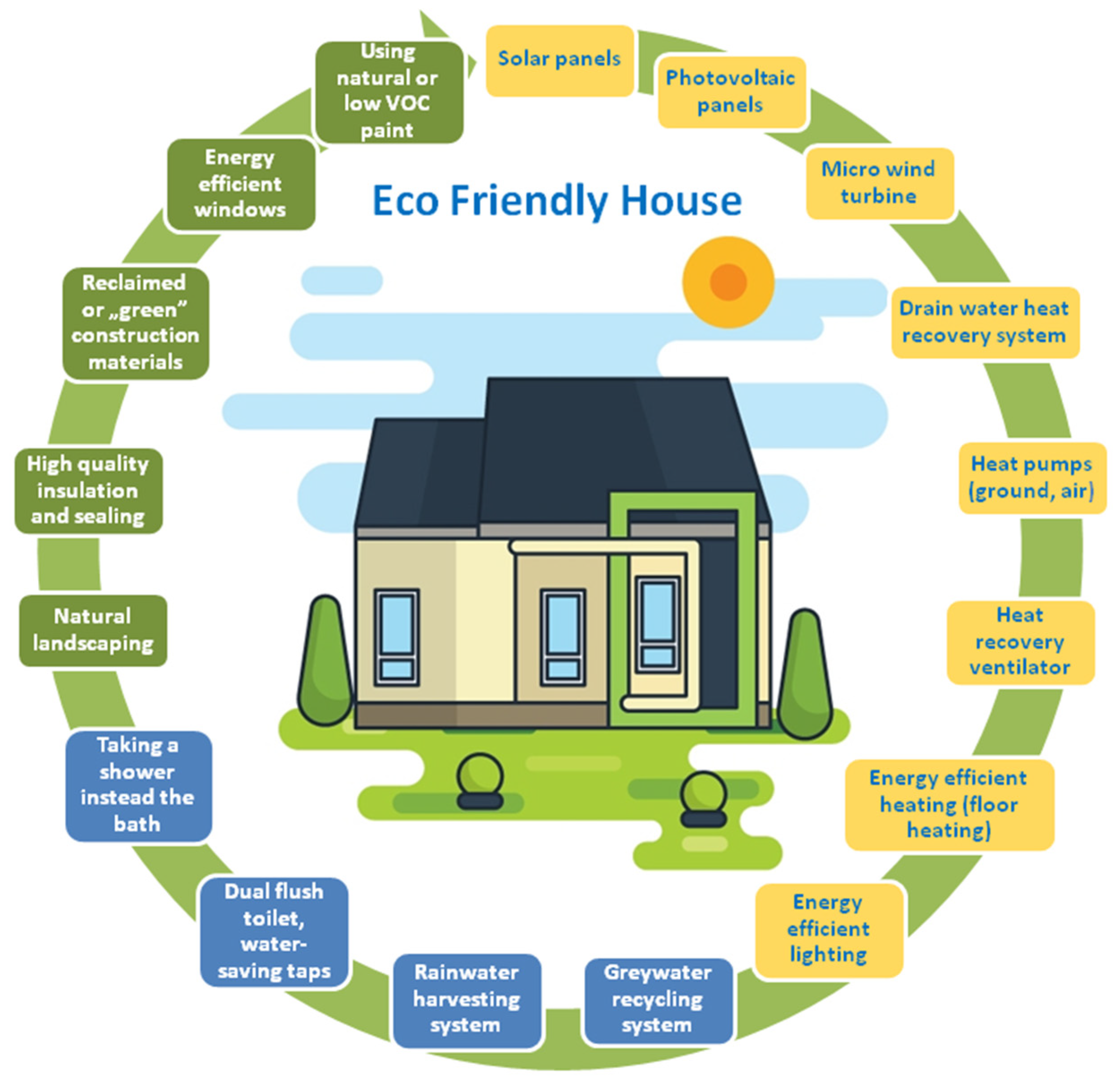
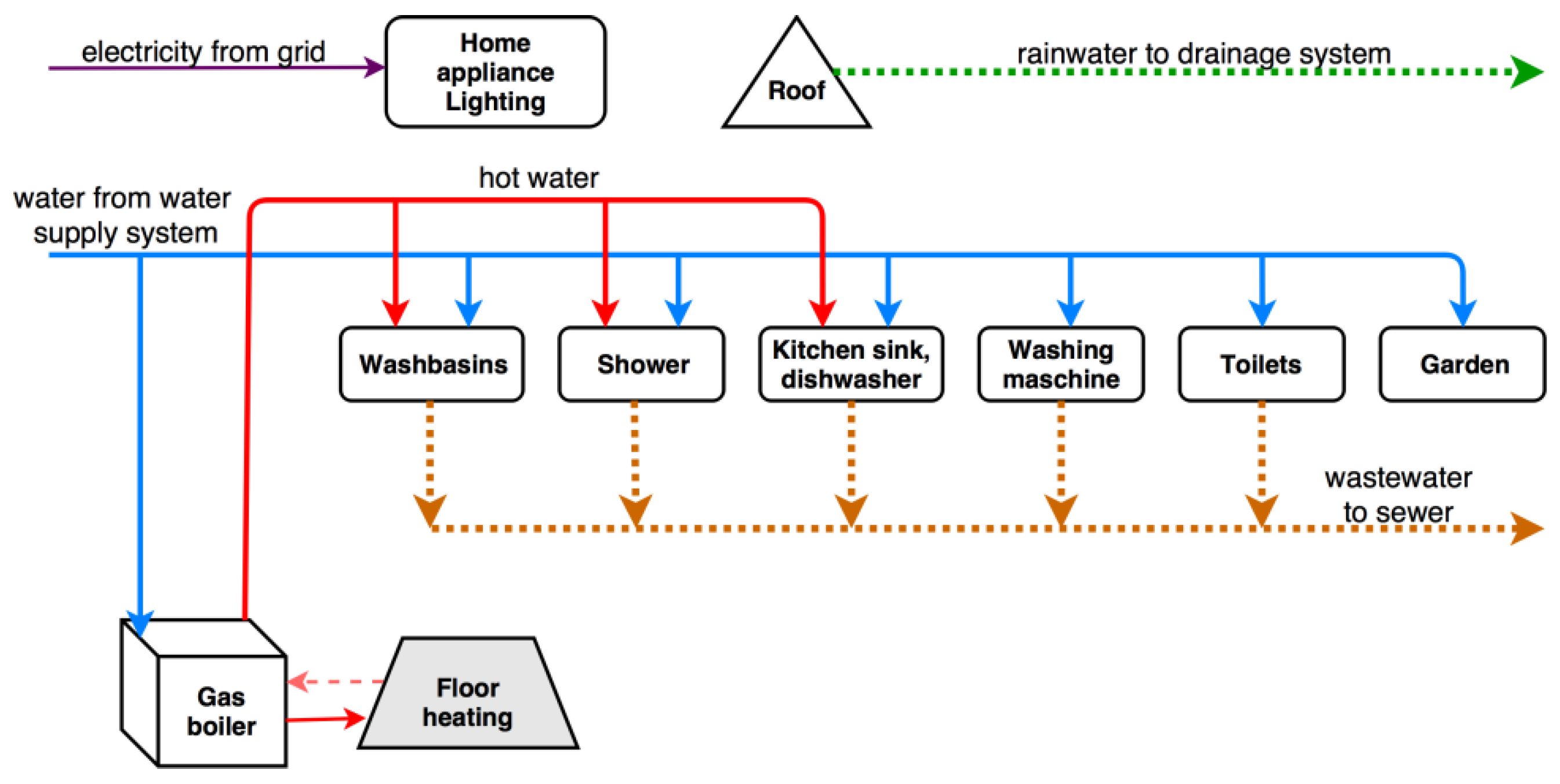
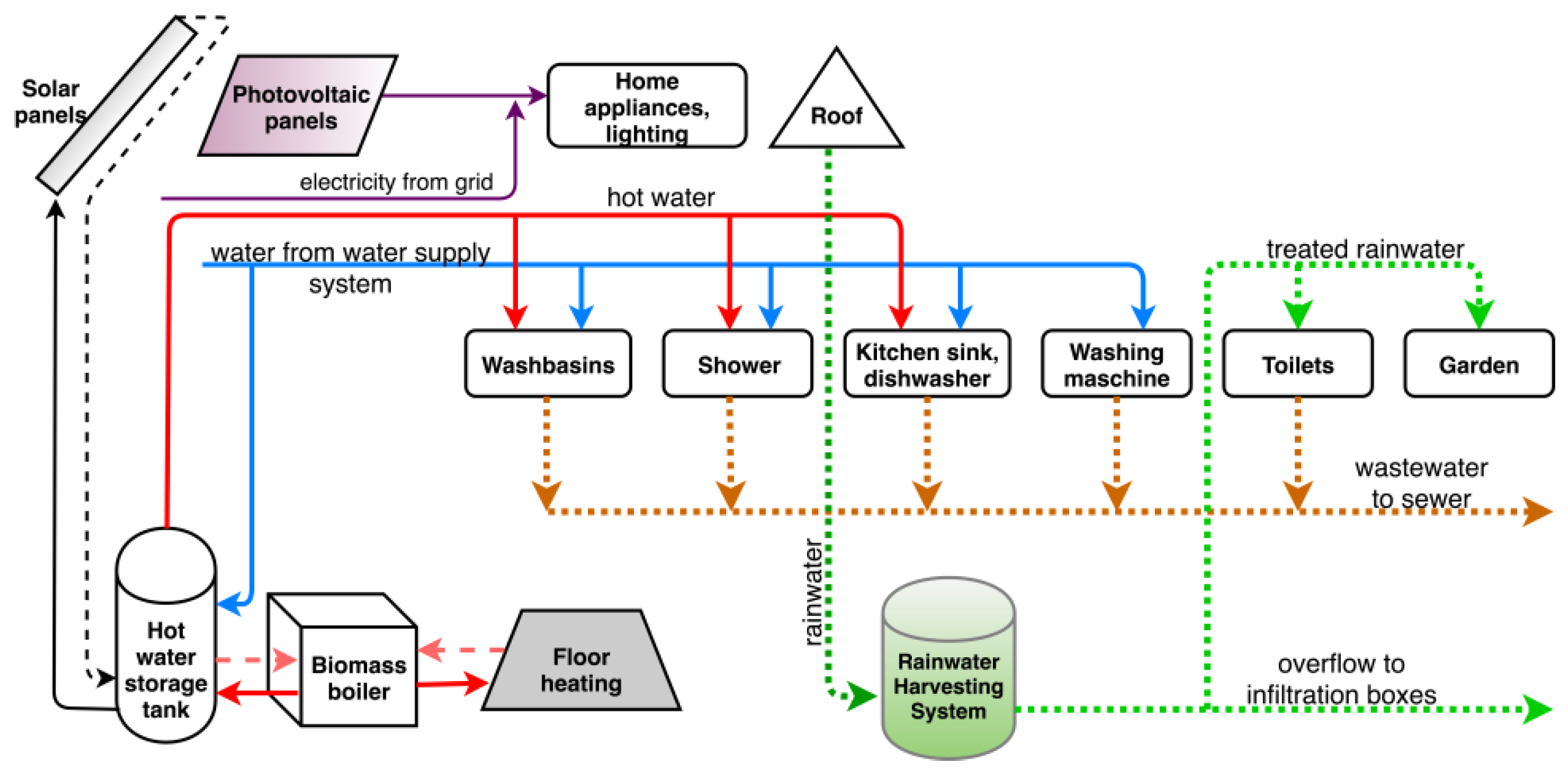
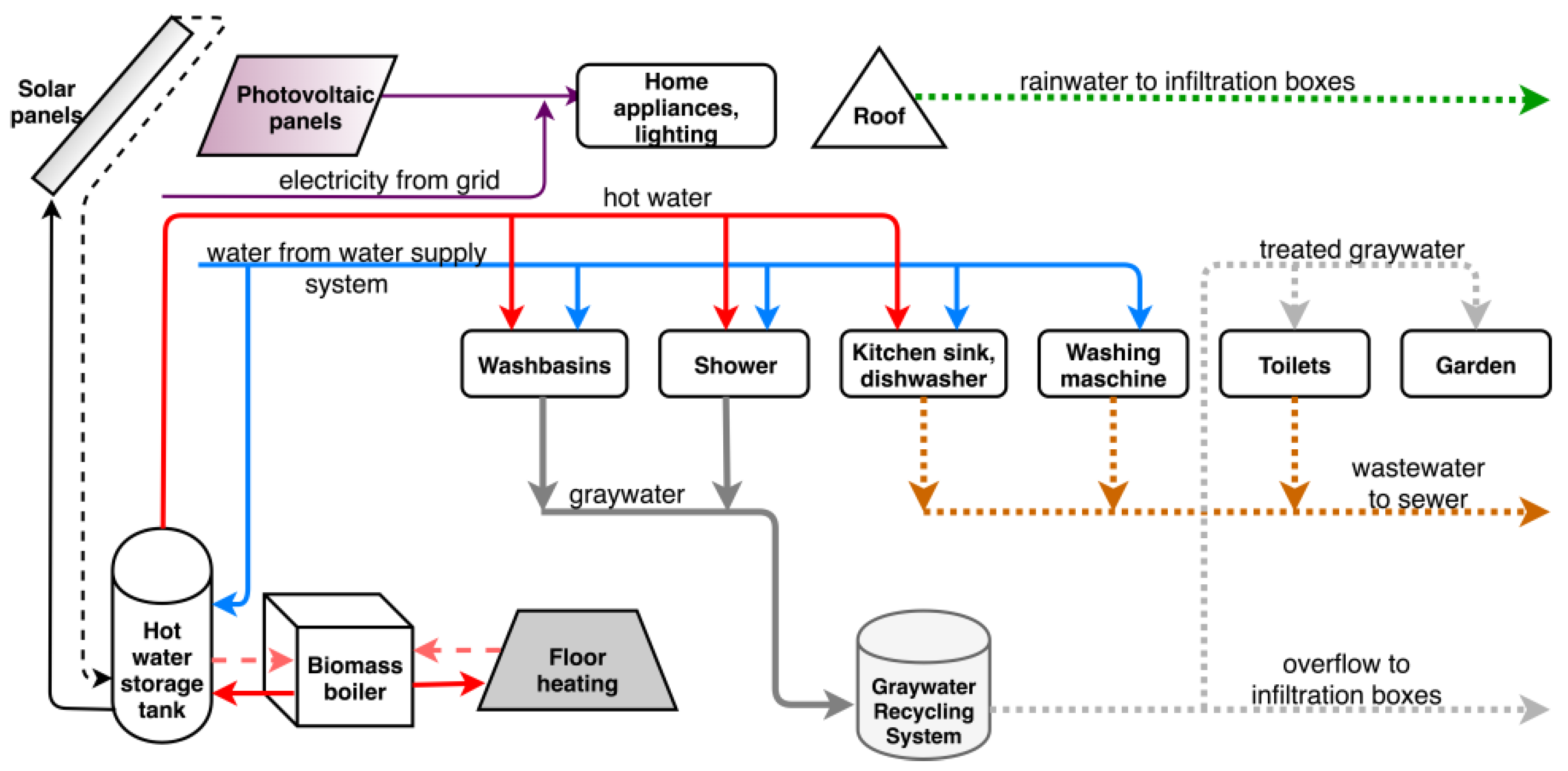

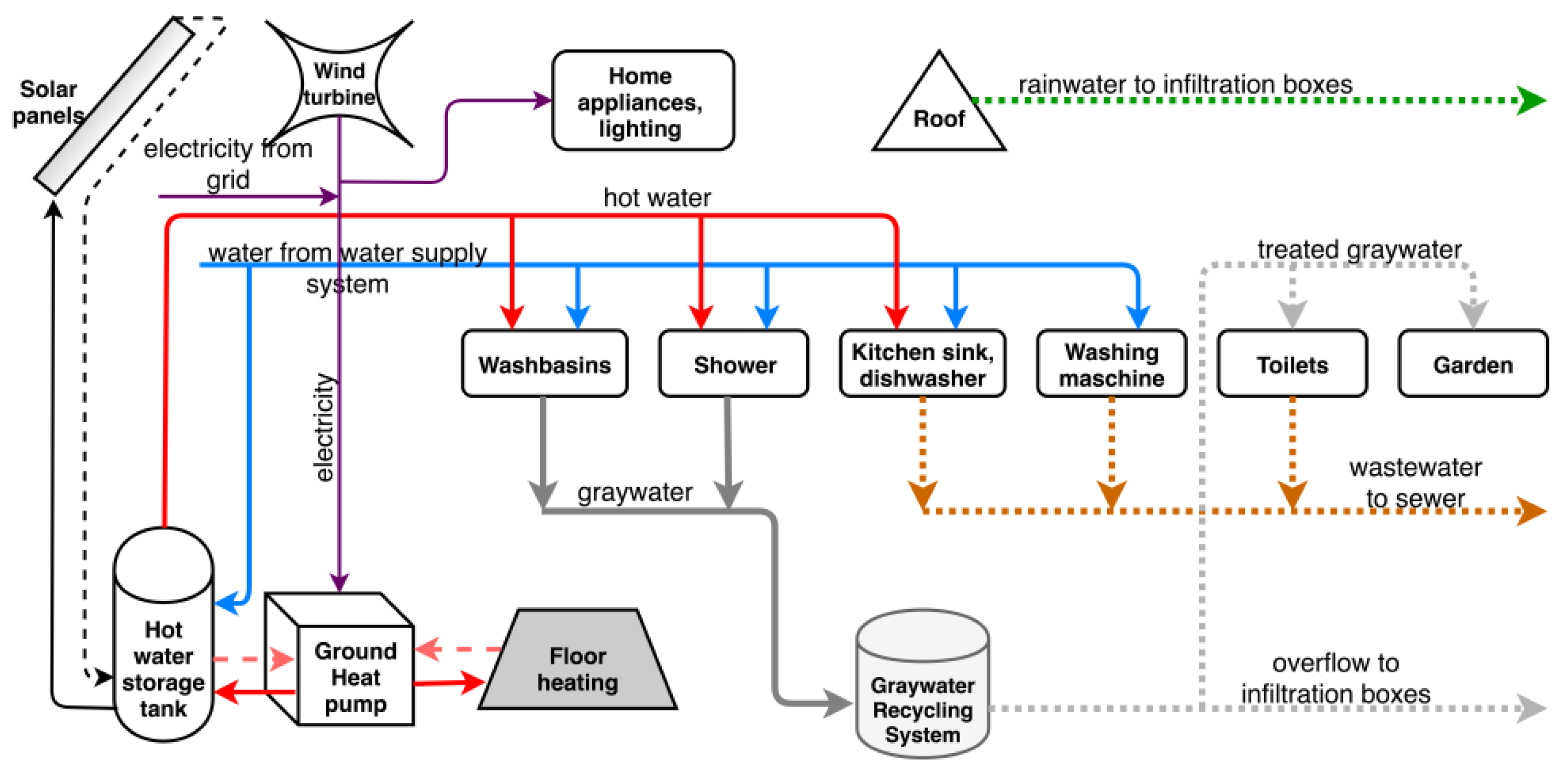
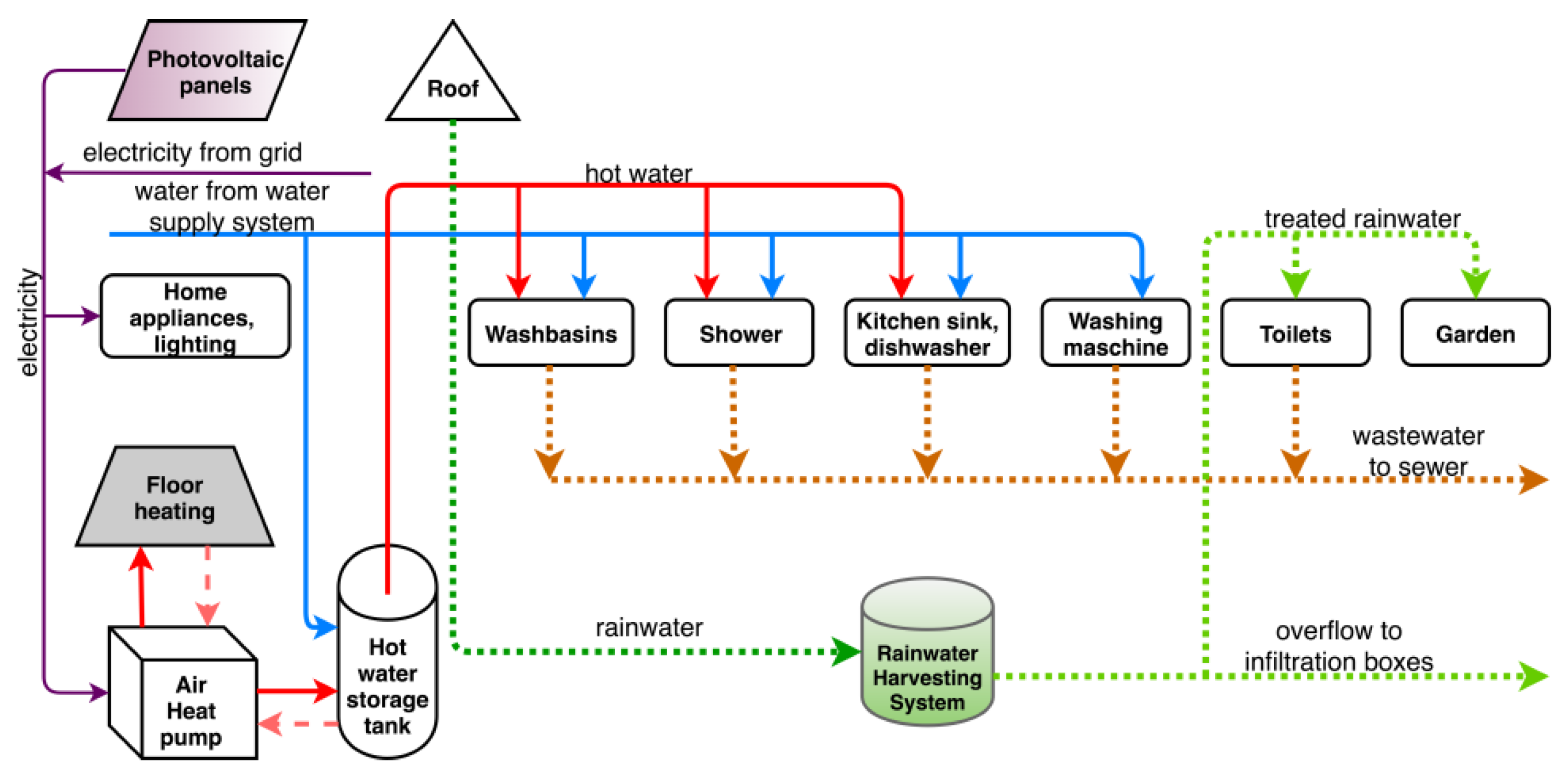
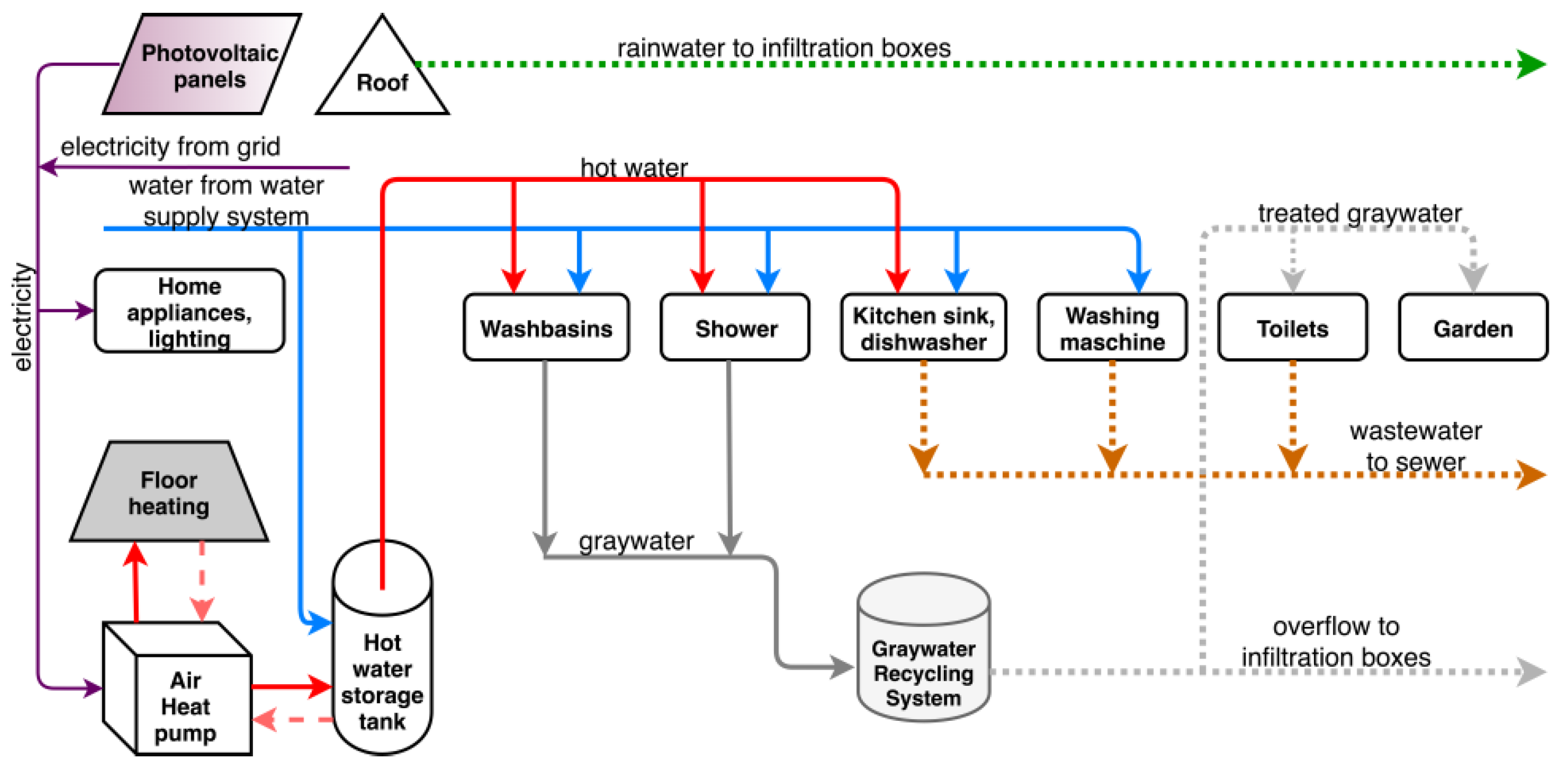
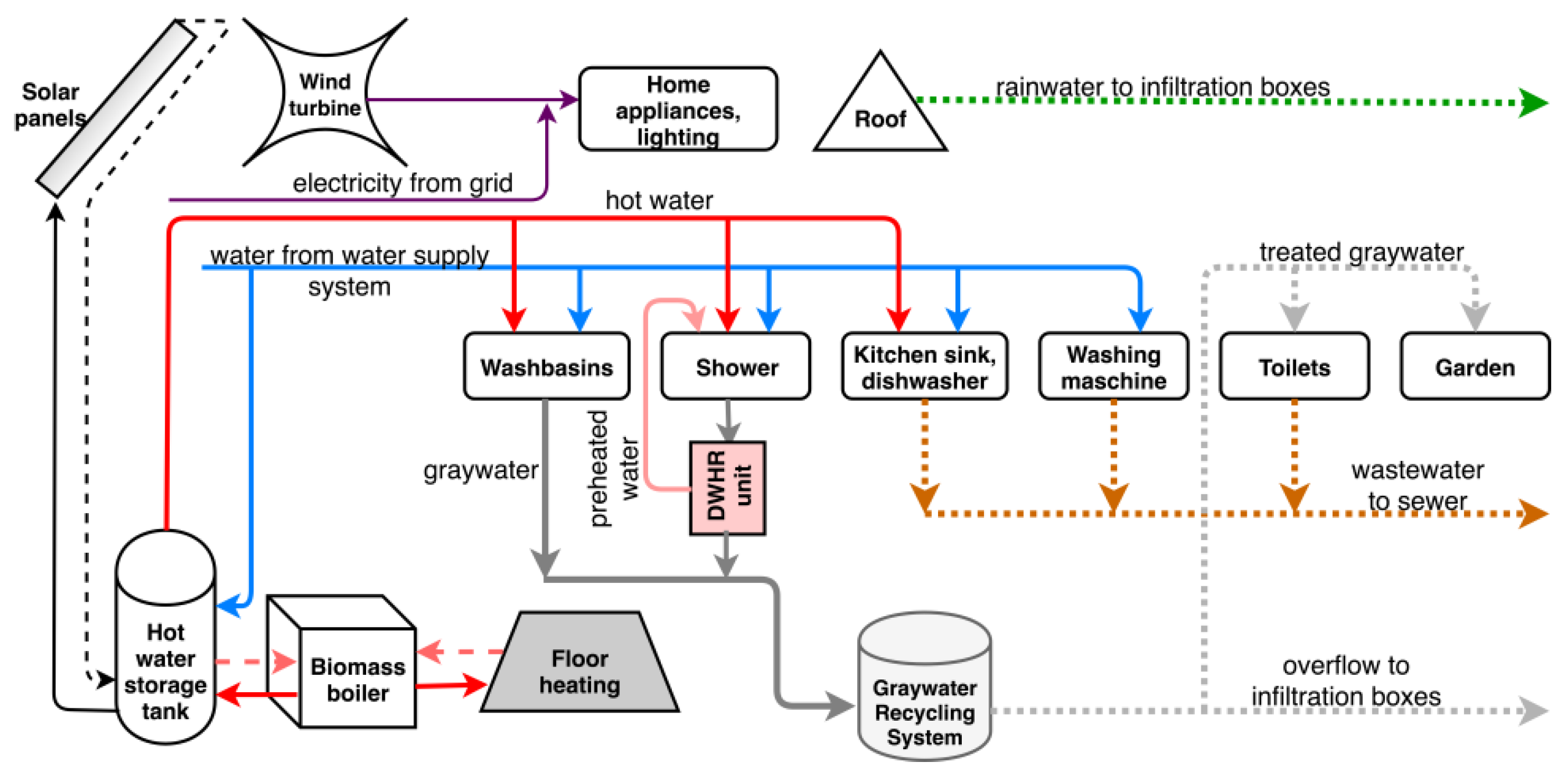
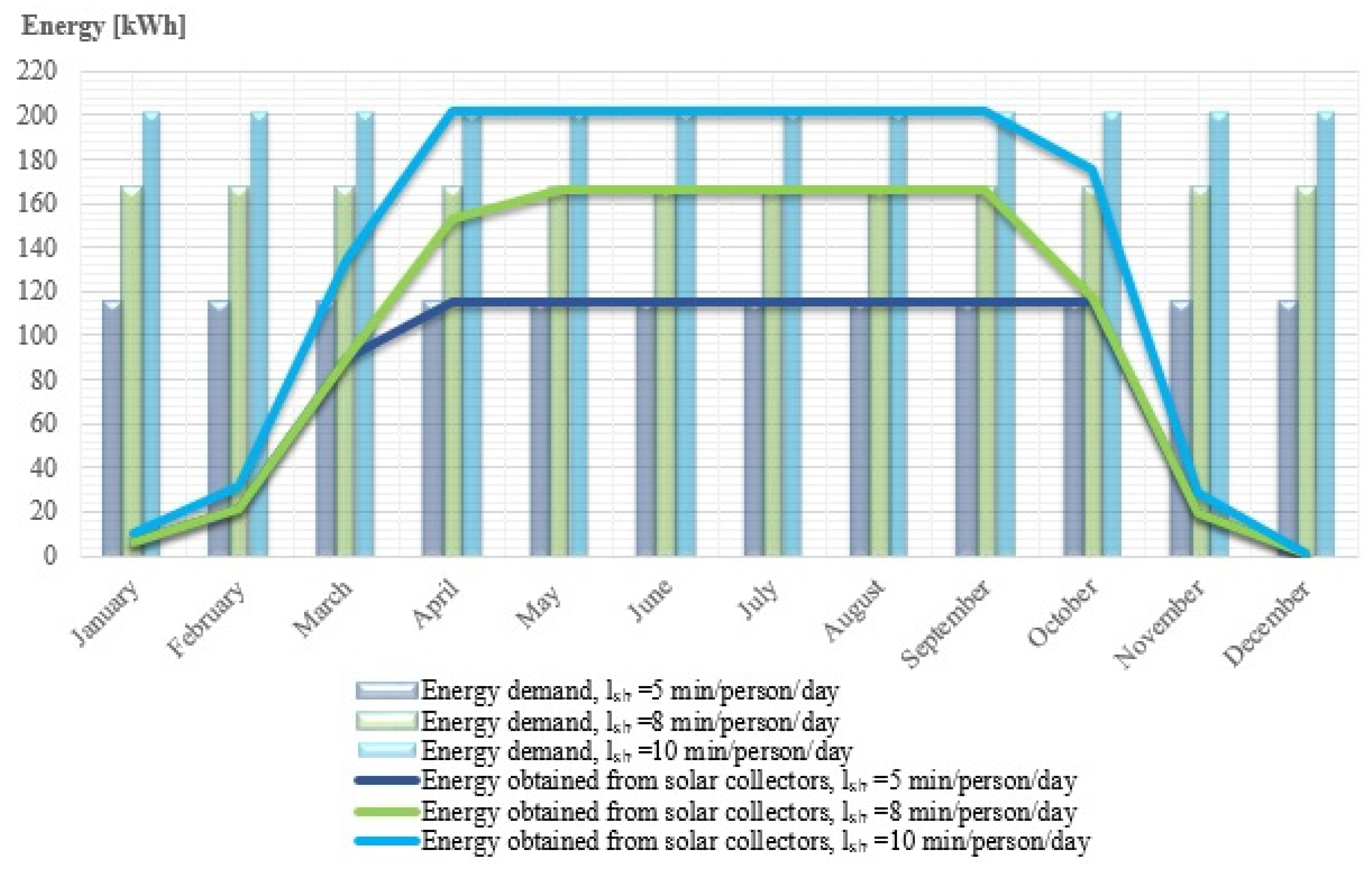
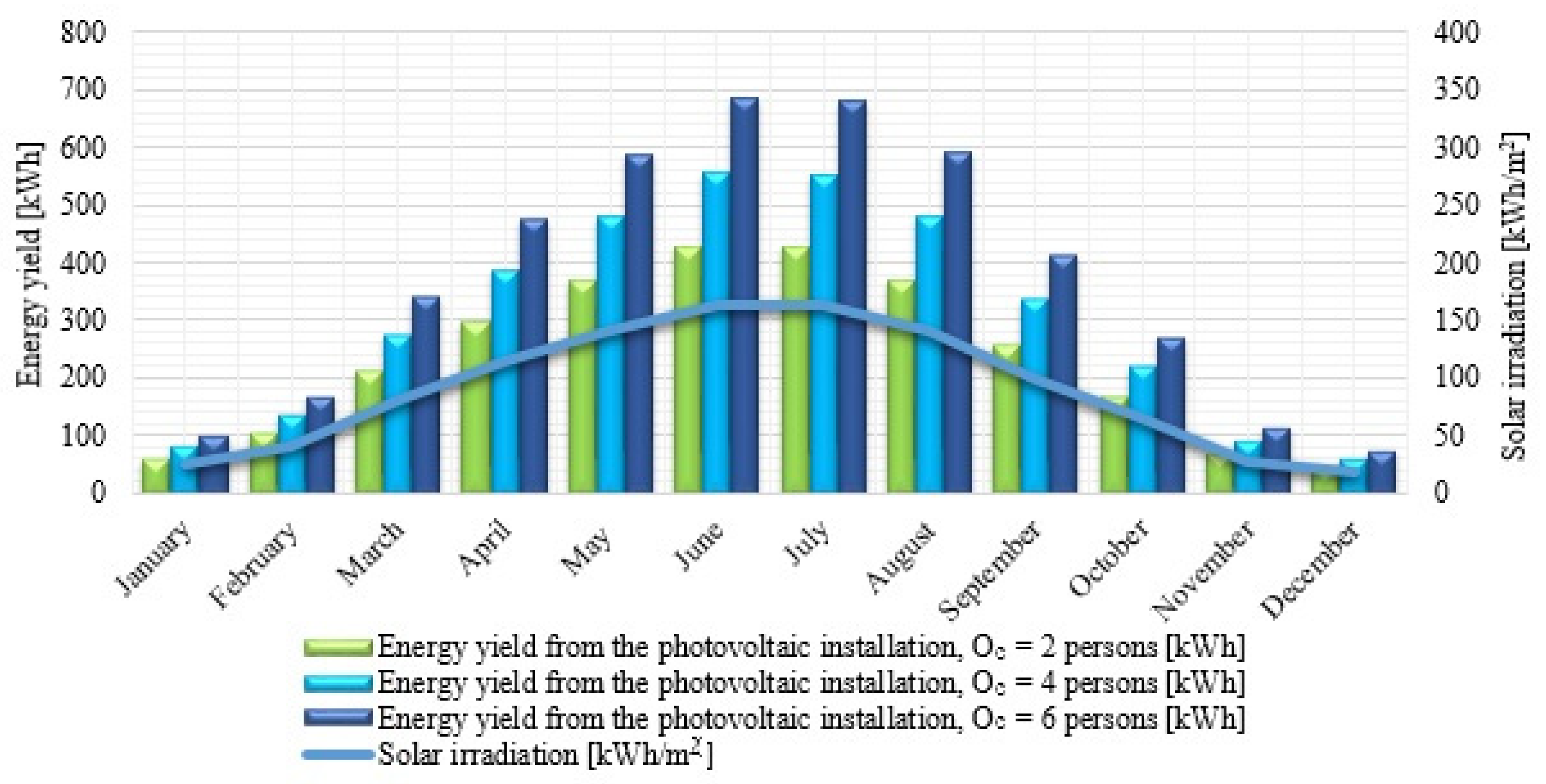
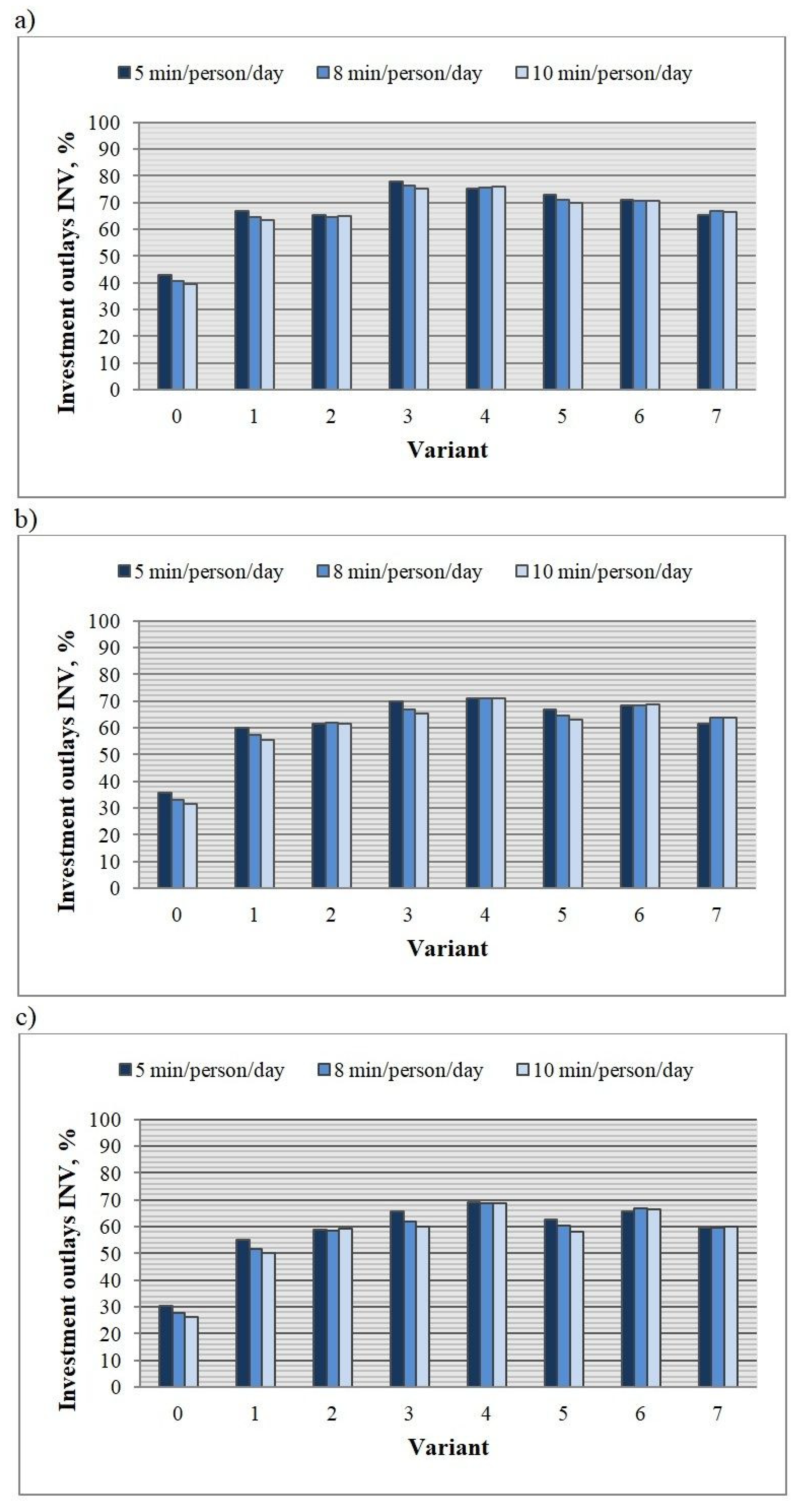
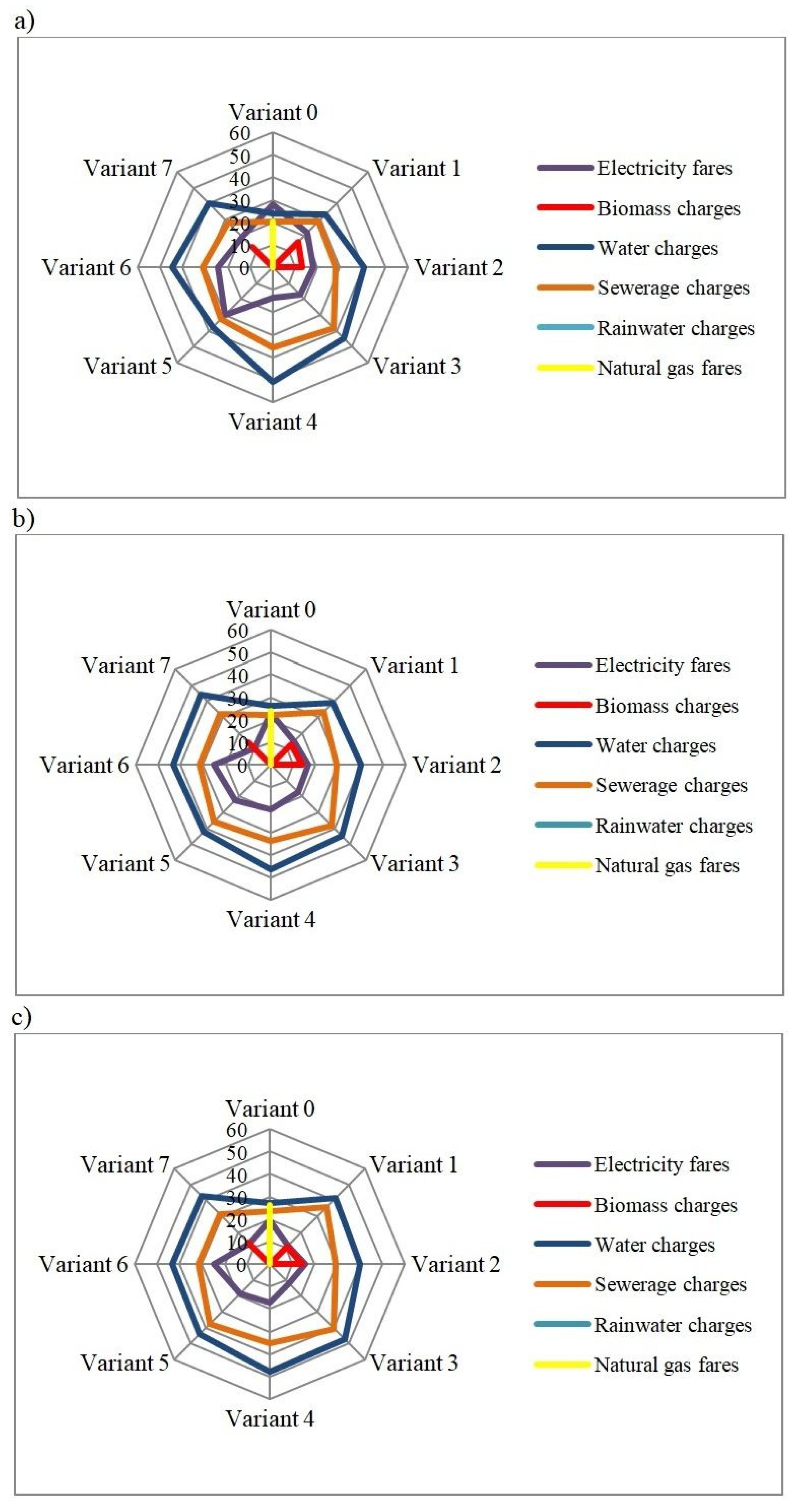
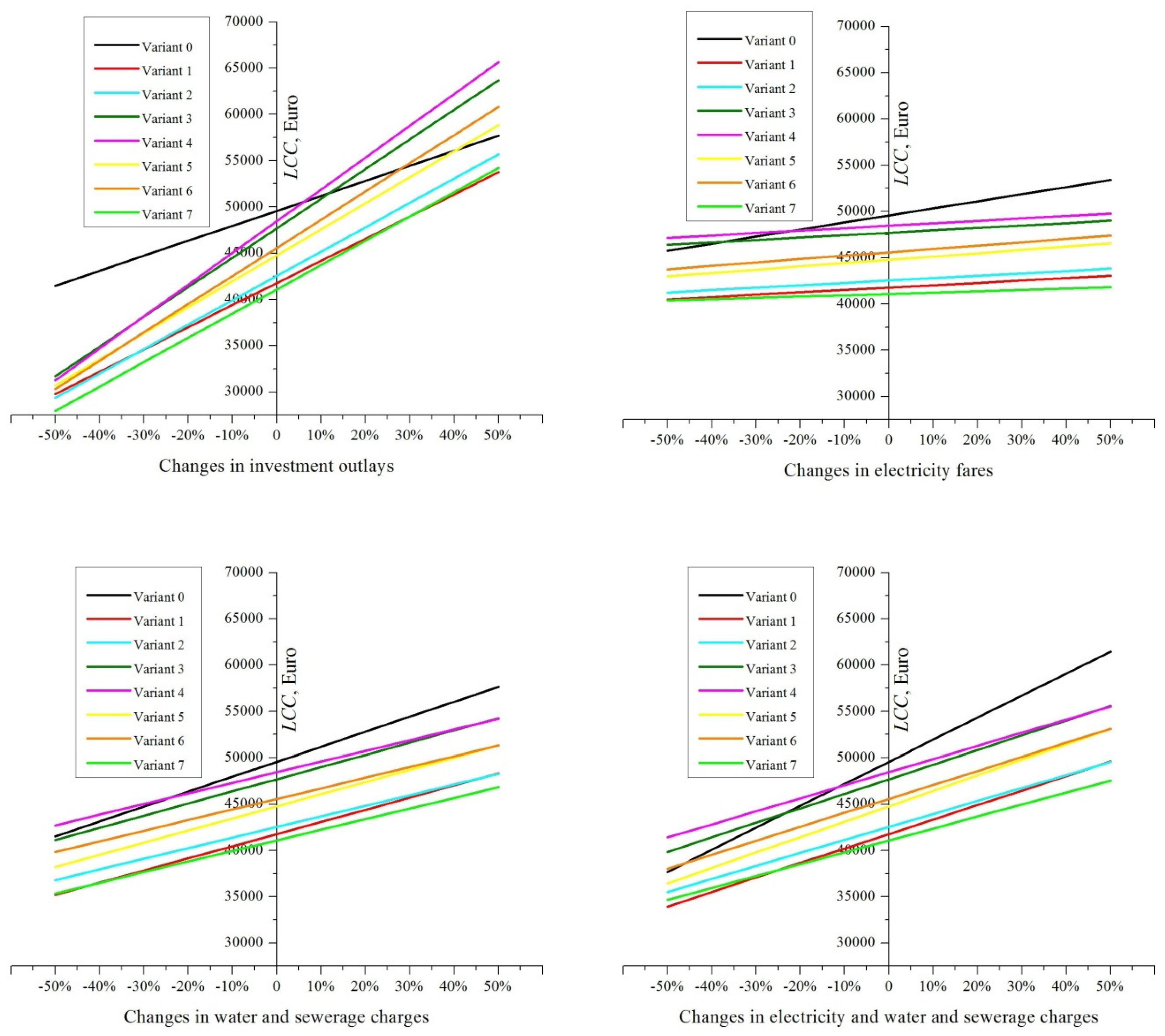
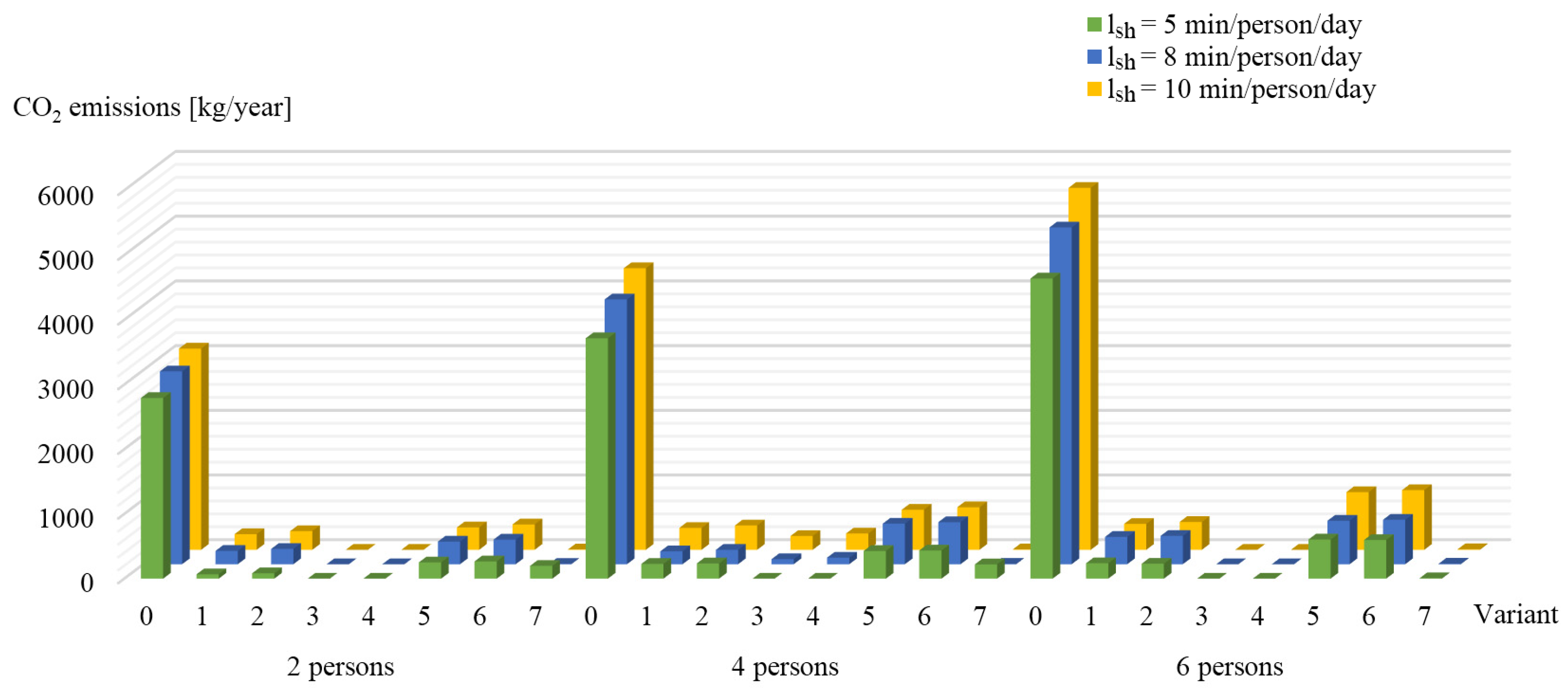
| Year | 2003 | 2004 | 2005 | 2006 | 2007 | 2008 | 2009 | 2010 | 2011 | 2012 | Average |
|---|---|---|---|---|---|---|---|---|---|---|---|
| Annual precipitation H, mm | 497 | 761 | 777 | 600 | 679 | 737 | 768 | 973 | 609 | 552 | 695 |
| Month | Solar Irradiation (kWh/m2) |
|---|---|
| January | 24.4 |
| February | 40.7 |
| March | 81.4 |
| April | 114 |
| May | 140.7 |
| June | 164 |
| July | 162.8 |
| August | 141.9 |
| September | 98.9 |
| October | 65.1 |
| November | 27.9 |
| December | 18.6 |
| Parameter | Parameter Value |
|---|---|
| Investments | |
| The cost of purchasing and installing the GWRS INVGWRS | 3222 €, 3580 €, 4010 € |
| The cost of purchasing and installing the RWHS INVRWHS | 1670 €, 1790 € |
| The cost of purchasing and installing the SC INVSC | 1866–4765 € |
| The cost of purchasing and installing the PP INVPP | 3510–9788 € |
| The cost of purchasing and installing the AHP INVAHP | 9337–11.266 € |
| The cost of purchasing and installing the GHP INVGHP | 10128–11.994 € |
| The cost of purchasing and installing the WT INVWT | 3571 €, 3810 €, 4286 €, 4762 € |
| The cost of purchasing and installing the DWHR unit INVDWHR | 680 € |
| The cost of purchasing and installing the BB INVBB | 1310 € |
| The cost of purchasing and installing the sanitary systems INV0 | 1320 € |
| The cost of purchasing and installing the infiltration boxes in variants with GWRS or RWHS INVB | 120 € |
| The cost of purchasing and installing the infiltration boxes in Variant 0 INVB0 | 478 € |
| The cost of making an installation of the floor heating in each variant | 4909 € |
| The cost of making a chimney with a flue pipe in Variant 0, 1, 7 | 2381 € |
| The cost of connection to the gas network in Variant 0 | 595 € |
| The cost of making connections to the power grid in each variant | 357 € |
| The cost of purchasing and installing recuperation installations in each variant | 4286 € |
| The cost of purchasing and installing condensing gas boiler in Variant 0 | 1548 € |
| The cost of purchasing and installing water tank in Variant 0 | 264–448 € |
| Operating costs | |
| The annual increase in electricity prices (purchasing and selling) ie | 1.5% |
| The annual increase in gas prices ig | 2% |
| The annual increase in the prices of purchase of water from the water-pipe network iw | 6% |
| The annual increase in the prices of rainwater discharge to the sewage network ir | 3% |
| The annual increase in the prices of sanitary sewage discharge to the sewage system is | 6% |
| The annual increase in the prices of purchase wood iwd | 3% |
| The cost of filter change in GWRS after 10 years | 477 €, 549 €, 597 € |
| The cost of purchasing electricity in the year 0 ce | 0.139 €/kWh |
| The cost of purchasing gas in the year 0 cg | 0.488 €/m3 |
| The cost of purchasing wood in the year 0 cw | 61.905 €/m3 |
| The cost of selling electricity in the year 0 cse | 0.045 €/kWh |
| The cost of purchasing water from the water-pipe network in the year 0 cw | 1.076 €/m3 |
| The cost of sanitary sewage discharge to the sewage network in the year 0 cs | 0.921 €/m3 |
| The cost of the discharge of rainwater to the sewage network in the year 0 cr | 0.715 €/m3 |
| The cost of purchasing wood for biomass boiler in the year 0 cwd | 50 €/m3 |
| Other parameters | |
| Analysis period T | 25 years |
| The discount rate r | 5% |
| Parameter | Parameter Value |
|---|---|
| Biomass boiler efficiency | 0.84 |
| Bifunctional, condensing gas boiler efficiency | 0.94 |
| The efficiency of a ground-source heat pump | 3.0 |
| The efficiency of an air-to-water heat pump | 2.6 |
| The efficiency of solar collectors | 0.64 |
| The efficiency of the recuperator | 0.9 |
| Projected external temperature | −20 °C |
| Average annual external temperature for the Rzeszów-Jasionka meteorological station | 7.6 °C |
| Cold water temperature Twc | 9 °C |
| Daily hot water consumption for purposes other than showering dsh | 9 dm3/person/day |
| Density of water | 985.63–999.78 kg/m3 |
| Hot water temperature Twh | 55 °C |
| Mixed water flow from the showerhead dwm | 8 dm3/min |
| Mixed water flow from washbasins and kitchen sink taps qwm’ | 4 dm3/min |
| Mixed water temperature Twm | 40 °C |
| Shower length lsh | 5, 8, 10 min/person/day |
| Specific heat of water cp | 4176.5–4193.0 J/(kg·K) |
| The number of occupants Oc | 2, 4, 6 persons |
| Heat pump standby time (tank utilization time) tz | 8 h |
| Accumulation coefficient φ | 0.3 |
| Parameter | Parameter Value |
|---|---|
| Electricity demand for lighting, household appliances | 1468–2698 kWh/year |
| Electricity demand for recuperator | 338 kWh/year |
| Electricity demand for auxiliary equipment for heating installations | 376–485 kWh/year |
| Efficiency of the solar module | 16.5% |
| Parameter | Parameter Value |
|---|---|
| Daily water consumption for garden watering dg | 1.25 dm3/m2/day |
| Daily water consumption for toilet flushing dtf | 35 dm3/person/day |
| Garden area Ga | 300 m2 |
| Roof area Ra | 200 m2 |
| Runoff coefficient Ψ | 0.9 |
| Shower length lsh | 5, 8, 10 min/person/day |
| Soil infiltration rate kf | 10–4 m/s |
| Storage volume in GWRS VGWRS | 250 dm3, 500 dm3, 750 dm3 |
| Storage volume in RWHS VRWHS | 2.5 m3, 3.0 m3 |
| The number of occupants Oc | 2, 4, 6 persons |
| Variant | lsh = 5 min/Person/Day | lsh = 8 min/Person/Day | lsh = 10 min/Person/Day | |||||||
|---|---|---|---|---|---|---|---|---|---|---|
| INV € | OC25 € | LCC € | INV € | OC25 € | LCC € | INV € | OC25 € | LCC € | ||
| 2 persons | 0 | 16.129 | 21.561 | 37.690 | 16.129 | 23.374 | 39.503 | 16.158 | 24.600 | 40.758 |
| 1 | 22.191 | 10.944 | 33.135 | 22.215 | 12.242 | 34.457 | 22.671 | 12.979 | 35.650 | |
| 2 | 24.220 | 12.828 | 37.048 | 24.244 | 13.192 | 37.435 | 24.700 | 13.403 | 38.103 | |
| 3 | 29.405 | 8377 | 37.781 | 30.830 | 9562 | 40.392 | 31.286 | 10.266 | 41.552 | |
| 4 | 31.433 | 10.262 | 41.695 | 32.858 | 10.512 | 43.370 | 33.314 | 10.610 | 43.925 | |
| 5 | 24.395 | 9767 | 34.162 | 24.590 | 10.908 | 35.497 | 24.784 | 11.605 | 36.389 | |
| 6 | 26.424 | 11.652 | 38.076 | 26.618 | 11.857 | 38.475 | 26.812 | 11.950 | 38.762 | |
| 7 | 24.372 | 12.899 | 37.271 | 24.972 | 12.400 | 37.372 | 24.996 | 12.576 | 37.572 | |
| 4 persons | 0 | 16.161 | 29.248 | 45.409 | 16.232 | 32.874 | 49.107 | 16.275 | 35.327 | 51.602 |
| 1 | 23.274 | 15.571 | 38.845 | 23.945 | 17.832 | 41.777 | 24.150 | 19.511 | 43.661 | |
| 2 | 25.303 | 15.727 | 41.030 | 26.332 | 16.204 | 42.536 | 26.537 | 16.684 | 43.221 | |
| 3 | 31.262 | 13.427 | 44.689 | 31.970 | 15.734 | 47.704 | 32.639 | 17.206 | 49.845 | |
| 4 | 33.291 | 13.583 | 46.874 | 34.357 | 14.106 | 48.463 | 35.026 | 14.312 | 49.338 | |
| 5 | 26.947 | 14.234 | 41.181 | 28.097 | 16.684 | 44.781 | 28.515 | 17.985 | 46.500 | |
| 6 | 28.976 | 14.390 | 43.366 | 30.484 | 15.096 | 45.580 | 30.902 | 15.158 | 46.060 | |
| 7 | 25.111 | 15.594 | 40.705 | 26.244 | 14.853 | 41.097 | 26.524 | 15.089 | 41.614 | |
| 6 persons | 0 | 16.232 | 36.935 | 53.167 | 16.275 | 42.375 | 58.650 | 16.313 | 46.052 | 62.365 |
| 1 | 24.586 | 19.928 | 44.514 | 25.135 | 23.545 | 48.680 | 25.985 | 25.733 | 51.719 | |
| 2 | 26.854 | 18.615 | 45.469 | 27.402 | 19.348 | 46.750 | 28.682 | 19.687 | 48.370 | |
| 3 | 32.699 | 16.988 | 49.688 | 33.518 | 20.481 | 53.999 | 34.174 | 22.753 | 56.927 | |
| 4 | 34.967 | 15.675 | 50.642 | 35.785 | 16.257 | 52.042 | 36.871 | 16.697 | 53.568 | |
| 5 | 28.844 | 18.626 | 47.469 | 31.271 | 21.827 | 53.098 | 31.690 | 24.399 | 56.089 | |
| 6 | 31.111 | 17.304 | 48.414 | 33.539 | 17.603 | 51.142 | 34.386 | 18.396 | 52.783 | |
| 7 | 26.453 | 17.815 | 44.268 | 27.198 | 18.339 | 45.538 | 28.180 | 18.673 | 46.853 | |
| Variant | lsh = 5 min/Person/Day | lsh = 8 min/Person/Day | lsh = 10 min/Person/Day | |||||||||||||
|---|---|---|---|---|---|---|---|---|---|---|---|---|---|---|---|---|
| SO2 | NOX | CO | CO2 | pył | SO2 | NOX | CO | CO2 | pył | SO2 | NOX | CO | CO2 | pył | ||
| kg | kg | Kg | kg | kg | kg | kg | kg | kg | kg | kg | kg | kg | kg | kg | ||
| 2 persons | 0 | 497 | 142 | 42 | 69.798 | 82 | 497 | 145 | 43 | 74.511 | 82 | 497 | 147 | 44 | 77.751 | 82 |
| 1 | 17 | 121 | 25 | 1681 | 412 | 56 | 142 | 30 | 5150 | 457 | 66 | 147 | 31 | 6055 | 466 | |
| 2 | 21 | 122 | 25 | 2066 | 413 | 65 | 144 | 30 | 5920 | 459 | 79 | 150 | 32 | 7210 | 468 | |
| 3 | 0 | 0 | 0 | 0 | 0 | 0 | 0 | 0 | 0 | 0 | 0 | 0 | 0 | 0 | 0 | |
| 4 | 0 | 0 | 0 | 0 | 0 | 0 | 0 | 0 | 0 | 0 | 0 | 0 | 0 | 0 | 0 | |
| 5 | 70 | 18 | 5 | 6275 | 12 | 98 | 25 | 7 | 8747 | 16 | 97 | 25 | 7 | 8658 | 16 | |
| 6 | 75 | 19 | 6 | 6660 | 12 | 107 | 27 | 8 | 9517 | 18 | 110 | 28 | 8 | 9813 | 18 | |
| 7 | 54 | 129 | 27 | 4933 | 412 | 0 | 119 | 24 | 151 | 416 | 0 | 124 | 25 | 158 | 434 | |
| 4 persons | 0 | 636 | 184 | 55 | 92.887 | 105 | 636 | 191 | 57 | 10.2313 | 105 | 636 | 195 | 58 | 10.8794 | 105 |
| 1 | 62 | 151 | 32 | 5697 | 484 | 54 | 168 | 35 | 4984 | 551 | 92 | 192 | 41 | 8453 | 606 | |
| 2 | 64 | 152 | 32 | 5890 | 485 | 60 | 170 | 36 | 5561 | 552 | 103 | 195 | 42 | 9416 | 608 | |
| 3 | 0 | 0 | 0 | 0 | 0 | 22 | 6 | 2 | 1949 | 4 | 60 | 15 | 5 | 5341 | 10 | |
| 4 | 0 | 0 | 0 | 0 | 0 | 28 | 7 | 2 | 2526 | 5 | 71 | 18 | 5 | 6303 | 12 | |
| 5 | 120 | 30 | 9 | 10.692 | 20 | 176 | 44 | 13 | 15.666 | 29 | 173 | 44 | 13 | 15474 | 29 | |
| 6 | 122 | 31 | 9 | 10.885 | 20 | 182 | 46 | 14 | 16.244 | 30 | 184 | 47 | 14 | 16436 | 30 | |
| 7 | 60 | 144 | 30 | 5525 | 461 | 0 | 141 | 28 | 180 | 495 | 0 | 149 | 30 | 189 | 520 | |
| 6 persons | 0 | 776 | 227 | 67 | 115.976 | 128 | 776 | 236 | 70 | 130.116 | 128 | 776 | 242 | 72 | 139.834 | 129 |
| 1 | 65 | 169 | 35 | 5951 | 545 | 116 | 208 | 45 | 10.576 | 644 | 109 | 223 | 47 | 10.006 | 701 | |
| 2 | 62 | 168 | 35 | 5759 | 545 | 120 | 209 | 45 | 10.961 | 645 | 118 | 225 | 48 | 10.776 | 702 | |
| 3 | 0 | 0 | 0 | 0 | 0 | 0 | 0 | 0 | 0 | 0 | 0 | 0 | 0 | 0 | 0 | |
| 4 | 0 | 0 | 0 | 0 | 0 | 0 | 0 | 0 | 0 | 0 | 0 | 0 | 0 | 0 | 0 | |
| 5 | 169 | 43 | 13 | 15.116 | 28 | 188 | 48 | 14 | 16.798 | 31 | 250 | 63 | 19 | 22.287 | 41 | |
| 6 | 167 | 42 | 13 | 14.924 | 28 | 193 | 49 | 15 | 17.183 | 32 | 258 | 65 | 20 | 23.057 | 43 | |
| 7 | 0 | 143 | 29 | 181 | 500 | 0 | 159 | 32 | 202 | 558 | 0 | 170 | 34 | 216 | 594 | |
© 2019 by the authors. Licensee MDPI, Basel, Switzerland. This article is an open access article distributed under the terms and conditions of the Creative Commons Attribution (CC BY) license (http://creativecommons.org/licenses/by/4.0/).
Share and Cite
Stec, A.; Mazur, A. An Analysis of Eco-Technology Allowing Water and Energy Saving in an Environmentally Friendly House—A Case Study from Poland. Buildings 2019, 9, 180. https://doi.org/10.3390/buildings9080180
Stec A, Mazur A. An Analysis of Eco-Technology Allowing Water and Energy Saving in an Environmentally Friendly House—A Case Study from Poland. Buildings. 2019; 9(8):180. https://doi.org/10.3390/buildings9080180
Chicago/Turabian StyleStec, Agnieszka, and Aleksandra Mazur. 2019. "An Analysis of Eco-Technology Allowing Water and Energy Saving in an Environmentally Friendly House—A Case Study from Poland" Buildings 9, no. 8: 180. https://doi.org/10.3390/buildings9080180
APA StyleStec, A., & Mazur, A. (2019). An Analysis of Eco-Technology Allowing Water and Energy Saving in an Environmentally Friendly House—A Case Study from Poland. Buildings, 9(8), 180. https://doi.org/10.3390/buildings9080180






